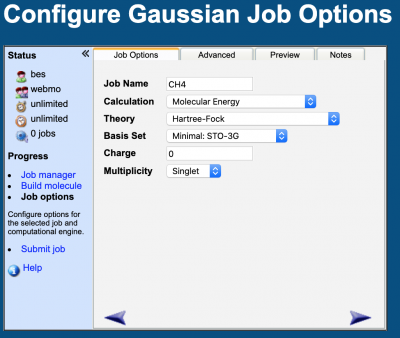Intro WebMO 1
The following activities is a modification of this...
Exercise 1 - Study of H-X-H Bond Angles
Exploring the structure of CH4
- - Click “New Job”, then “Create New Job”. The Build Molecule window opens,
- - Click on the Periodic Table icon (2nd down the left side). Choose “C” by clicking on it.
- - Click once in the center of the workspace. A dark-gray carbon atom appears. (If you click too many
times and have extra atoms, choose Edit > Undo).
- - Choose Clean-Up > Comprehensive – Mechanics. This request will add hydrogens and you should now seen methane.
- - Experiment with the Rotate, Translate, and Zoom tools (3rd, 4th, 5th icons on left side).
This structure contains idealized bond lengths and angles. A more accurate structure can be found by carrying out an energy minimization using molecular mechanics, semiempirical methods, or ab initio calculations.
- - Click the blue “continue” arrow in the lower right side of the Build Molecule window.
- (Note: only one computational engine has been enabled, so you do not need to choose the engine, this many chang ein the future).
- - Setup the job using the "Configure Gaussian Job Options" window as shown below:

Type in/Choose the following: Job Name: CH4 PM3 Geom Opt Calculation: Geometry Optimization Theory: PM3 Charge: 0 Multiplicity: Singlet Click on the blue “continue” arrow. You should now see your job listed.
To kill or stop a job, you would click on the red “X” under Actions on the right side.
Click Refresh (every ~10 seconds) until you see that your job is Complete (under Status). Click on the hyperlinked name (CH4 PM3 Geom Opt) to open the “View Job” window. Choose the Select arrow (4th icon down on left). Click on one of the H atoms in the structure (the other atoms and bonds will “fade”). Shift and Click the C atom (both atoms are now highlighted). The bond length is displayed just below the molecule. Record the value of the C-H bond length
___________Å (1.091 Å literature). Check the other C-H bond lengths.
Click on one of the H atoms, then Shift and click the C atom, followed by another H atom. The
bond angle is displayed just below the molecule. Record the value of the H-C-H bond angle ___________° (109.4712 literature). Check the other H-C-H bond angles.
Scroll down and review the information under Calculated Quantities. When finished, click the Job Manager link under Actions (to the left of the molecule display). To delete files, click the box to the left of the desired file and choose Delete on the menu. To continue on to the next exercise, choose New Job > Create New Job. Structure of NH3 Build NH3 using the above procedure. Use Job Name H3N PM3 Geom Opt, and perform the geometry optimization as before (PM3). Record the value of the N-H bond length __________Å (~0.999 Å, 1.012 Å literature). Record the value of the H-N-H bond angle __________° (~107.8 °, 106.67 ° literature). Scroll down and review the information under Calculated Quantities. Click on the magnifying
glass next to the reported Dipole Moment, then rotate the molecule to see the vector.
Return to Job manager, and choose New Job > Create New Job. Structure of H2O Build H2O using the above procedure. Use Job Name H2O PM3 Geom Opt, and perform the geometry optimization as before (PM3). Perform the PM3 geometry optimization as above. Record the value of the O-H bond length __________Å (~0.951 Å, 0.959 Å literature). Record the value of the H-O-H bond angle __________° (~107.7 °, 103.9 ° literature). Check out the Dipole Moment, as with NH3 above. Return to Job Manager. 1. What conclusion(s) can you make concerning the H-X-H bond angle and the number of unshared (lone) pairs of electrons around the central atom X? 2. What conclusions can you make concerning the size of the central atom X and the X-H bond length?